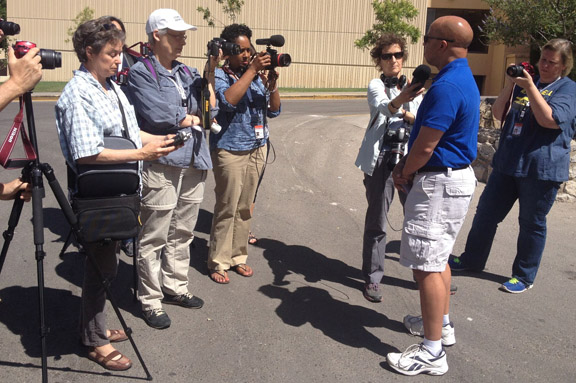Sixteen journalism instructors from Hispanic Serving Institutions and Historically Black Colleges and Universities have been selected to participate in the seventh annual Dow Jones News Fund Multimedia Training Academy in late May at the University of Texas in El Paso.
Thanks to a grant provided by the Dow Jones News Fund, Borderzine organizes this seventh annual workshop training geared to multimedia journalism instructors who teach in institutions with a large minority population.
Here is a list of the 16 chosen instructors and their institutions:
Eilene Wollslager, Our Lady of the Lake Texas
Sissel McCarthy, Hunter College
Myna German, Delaware State University
Cleo Allen, Dillard University
Stacey Patton, Morgan State University
Karima Haynes, Bowie State University
Benjamin Davis, California State University Northridge
Alice Stephens, Clark-Atlanta University
Gwyneth Doland, University of New Mexico
Michael DiBari, Hampton University
Bonnie Stewart, California State University Fullerton
Sheryl Kennedy Haydel, Xavier University of Louisiana
Stu VanAirsdale, Sacramento State University
Jenny Moore, Texas A&M San Antonio
Indira Somani, Howard University
Hugo Perez, New Mexico State University
This intense multimedia-journalism academy has a proven track record of six successful years helping journalism educators acquire a new skill set in multimedia production.
“The trainers at the academy understand what educators need to learn about new and emerging technologies to better prepare their students for the fast-changing future” said Linda Shockley, Managing Director of Dow Jones News Fund. “This quality of instruction at absolutely no cost to participants and their universities is priceless.”
The goal of this experience is to learn and practice new storytelling skills through the use of current technology. Participating instructors are expected to translate this learning into skills for their students making them more competitive and employable.
The participants come from different teaching backgrounds, specializing in print, photojournalism, broadcast or radio, to name a few. Since technology is changing so rapidly, it is essential for college instructors to expand their knowledge and increase their skills to teach multimedia journalism effectively. Current media organizations are looking for journalists who know more than just write, take pictures or do video.
This hands-on training also gives instructors a real life experience of how involved and time-consuming a multimedia production can be, and it gives them a chance to collaborate with peers that are struggling with the same challenges.
Co-directors, Zita Arocha and Kate Gannon, the Academy trainers and the Borderzine staff are excited to be training a seventh crop of instructors to help better prepare the next generation of Latino and African-American college journalists.


